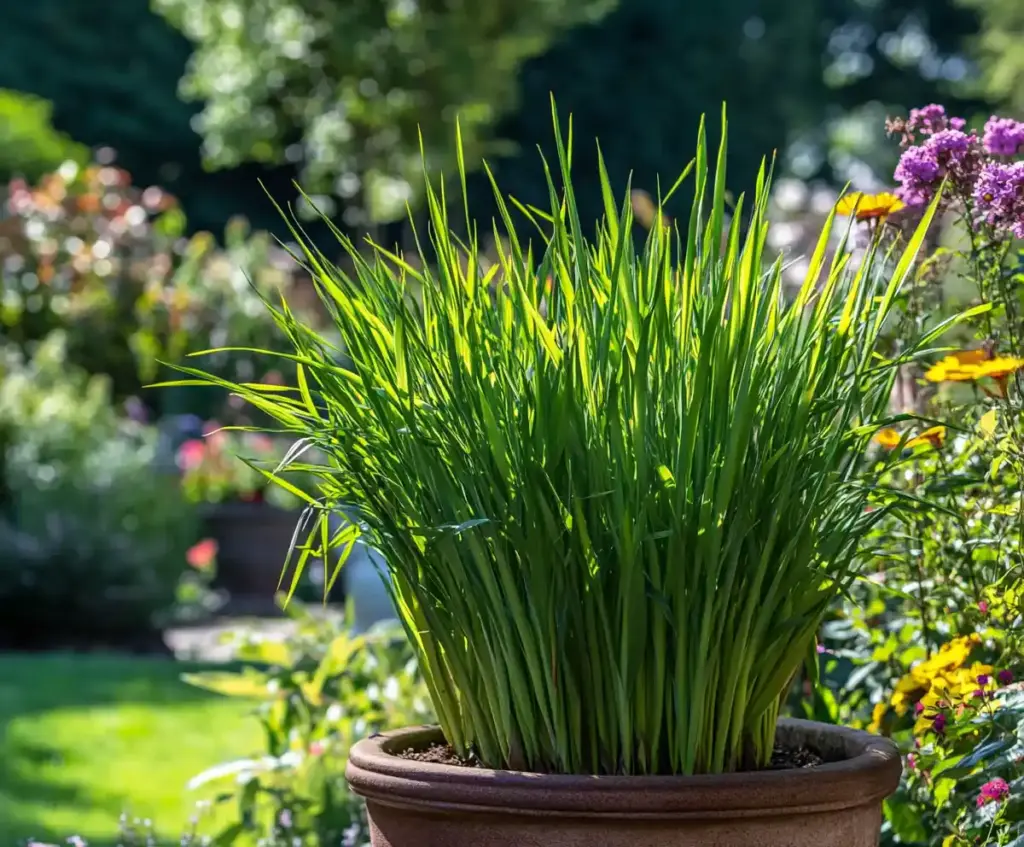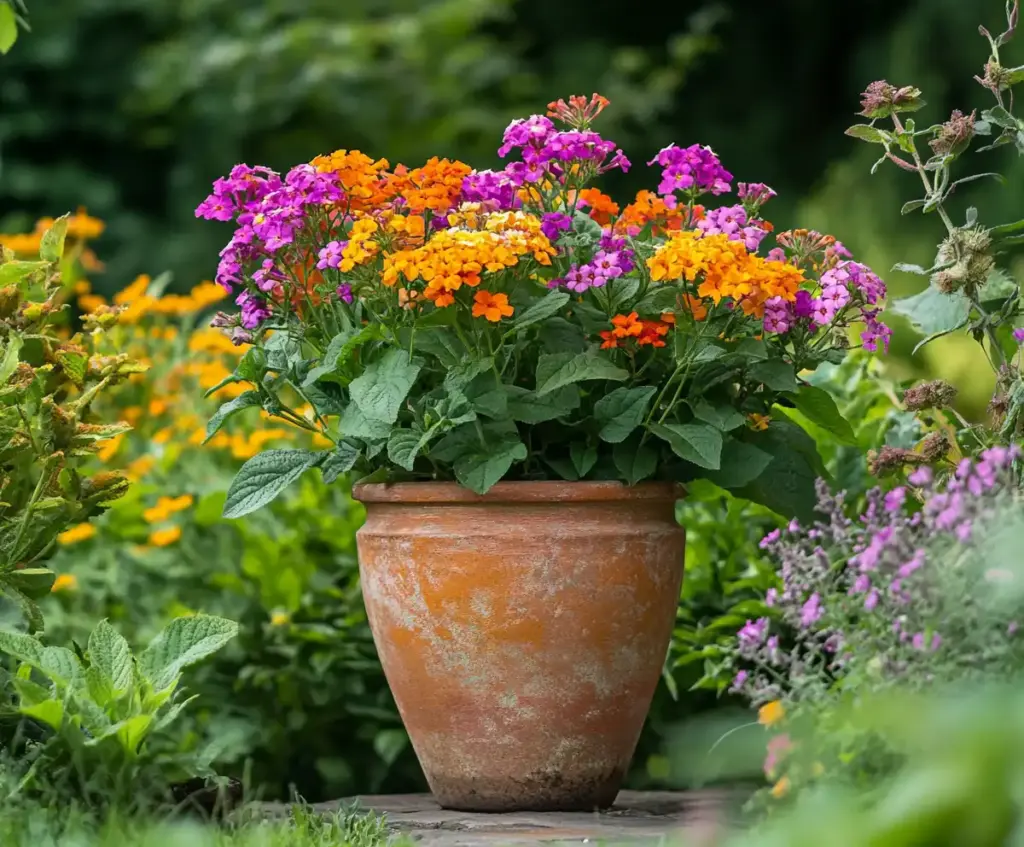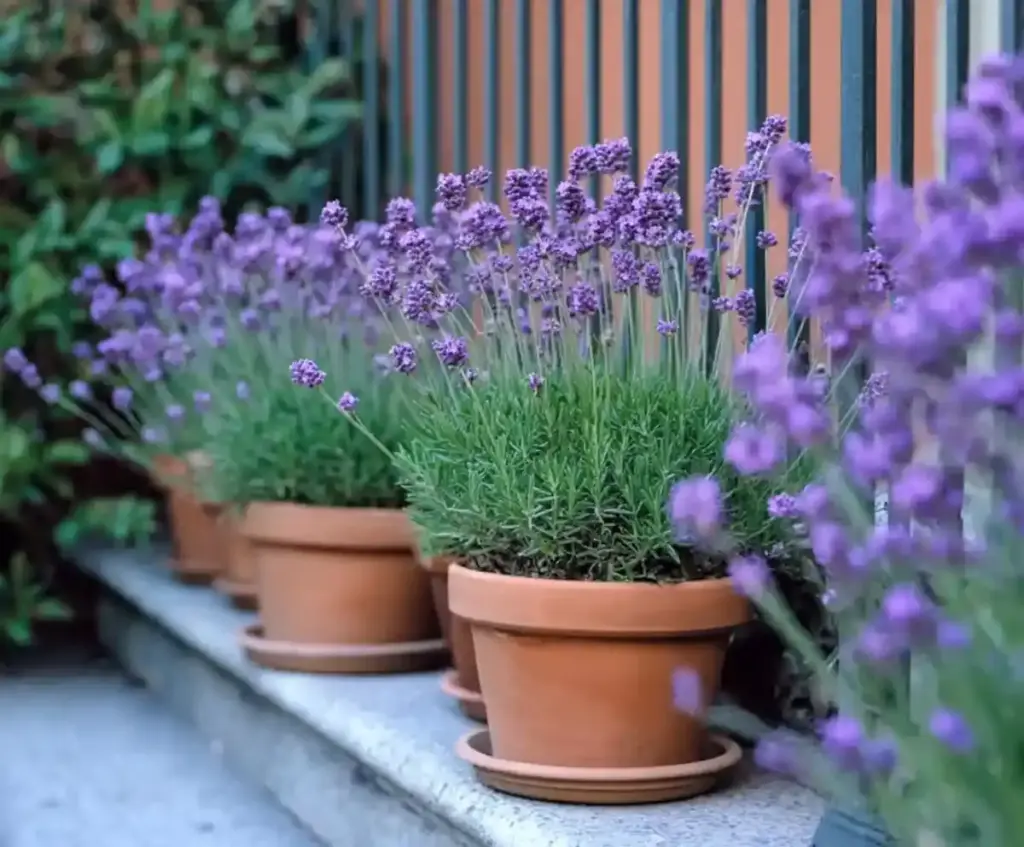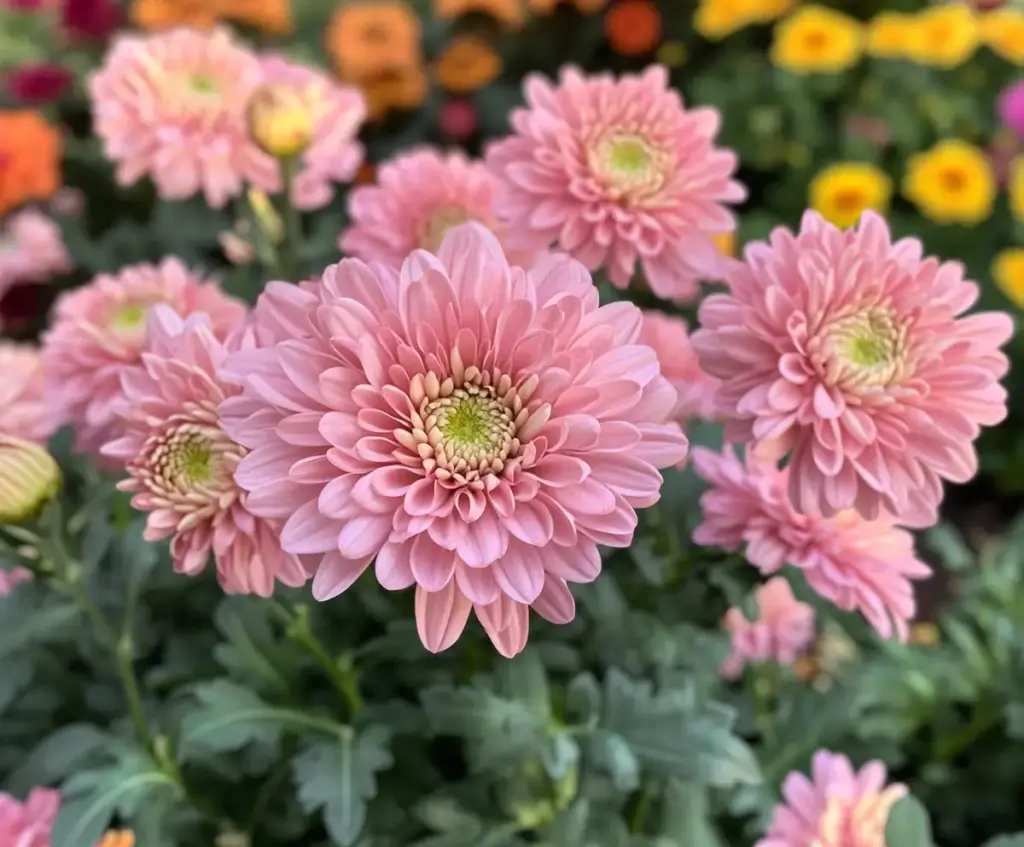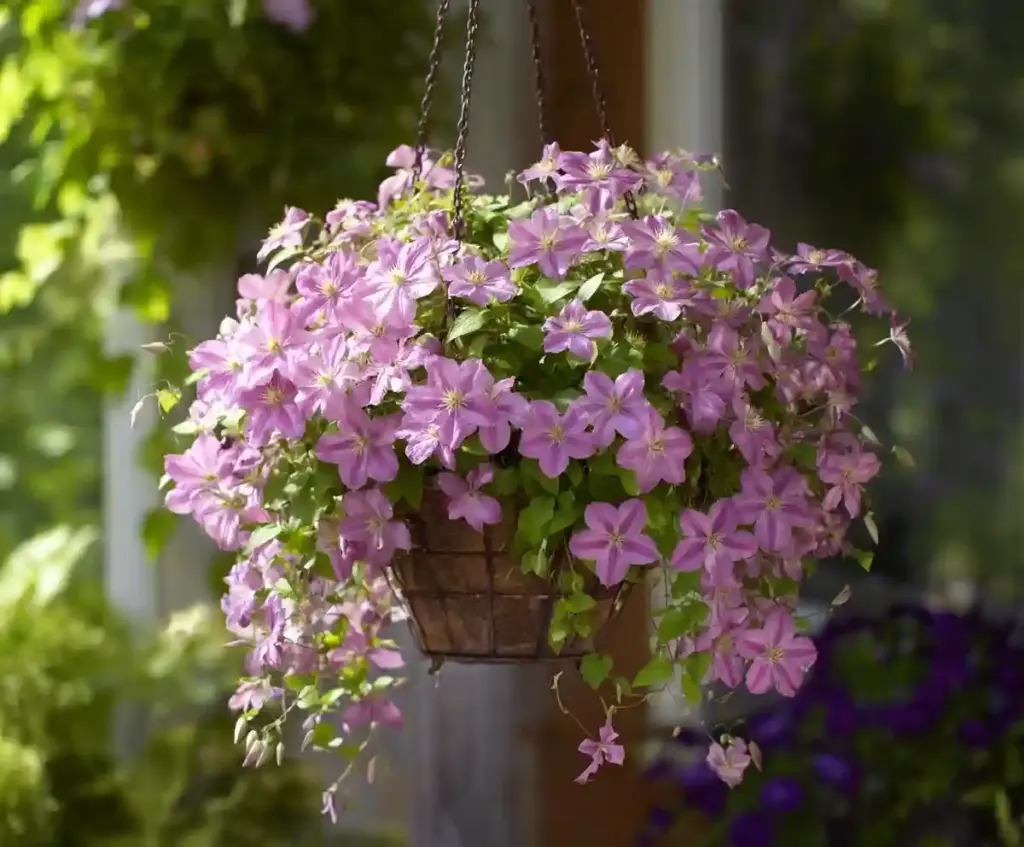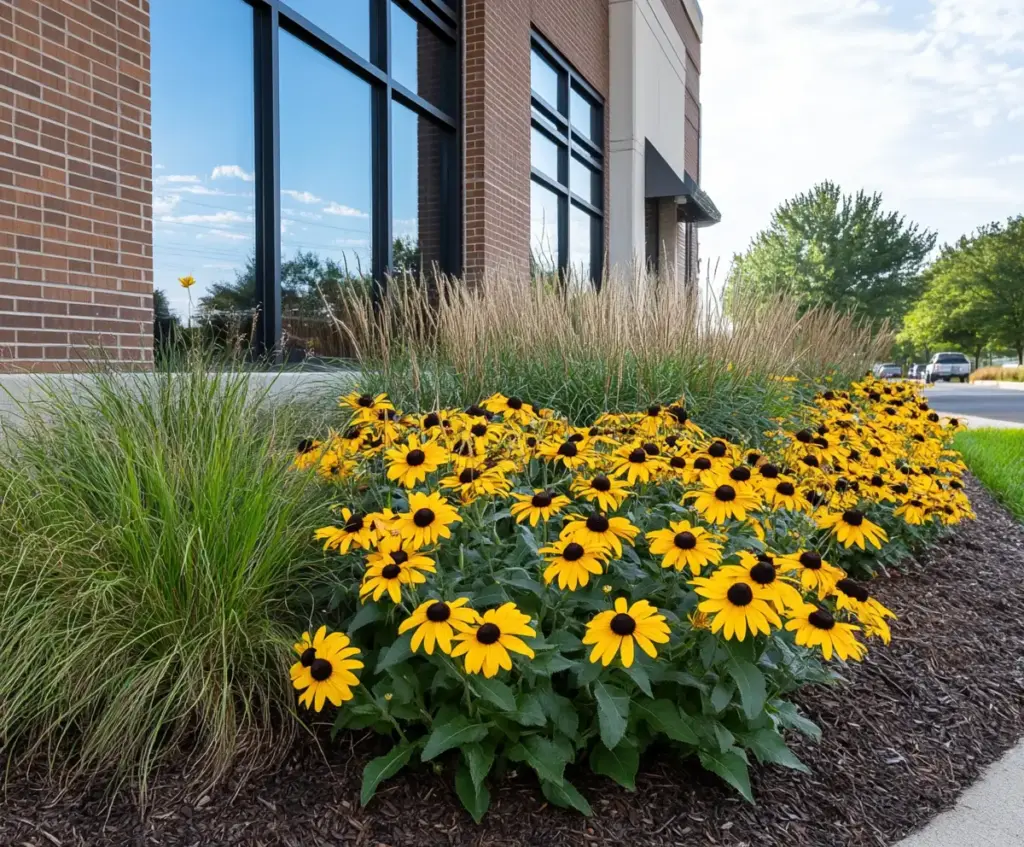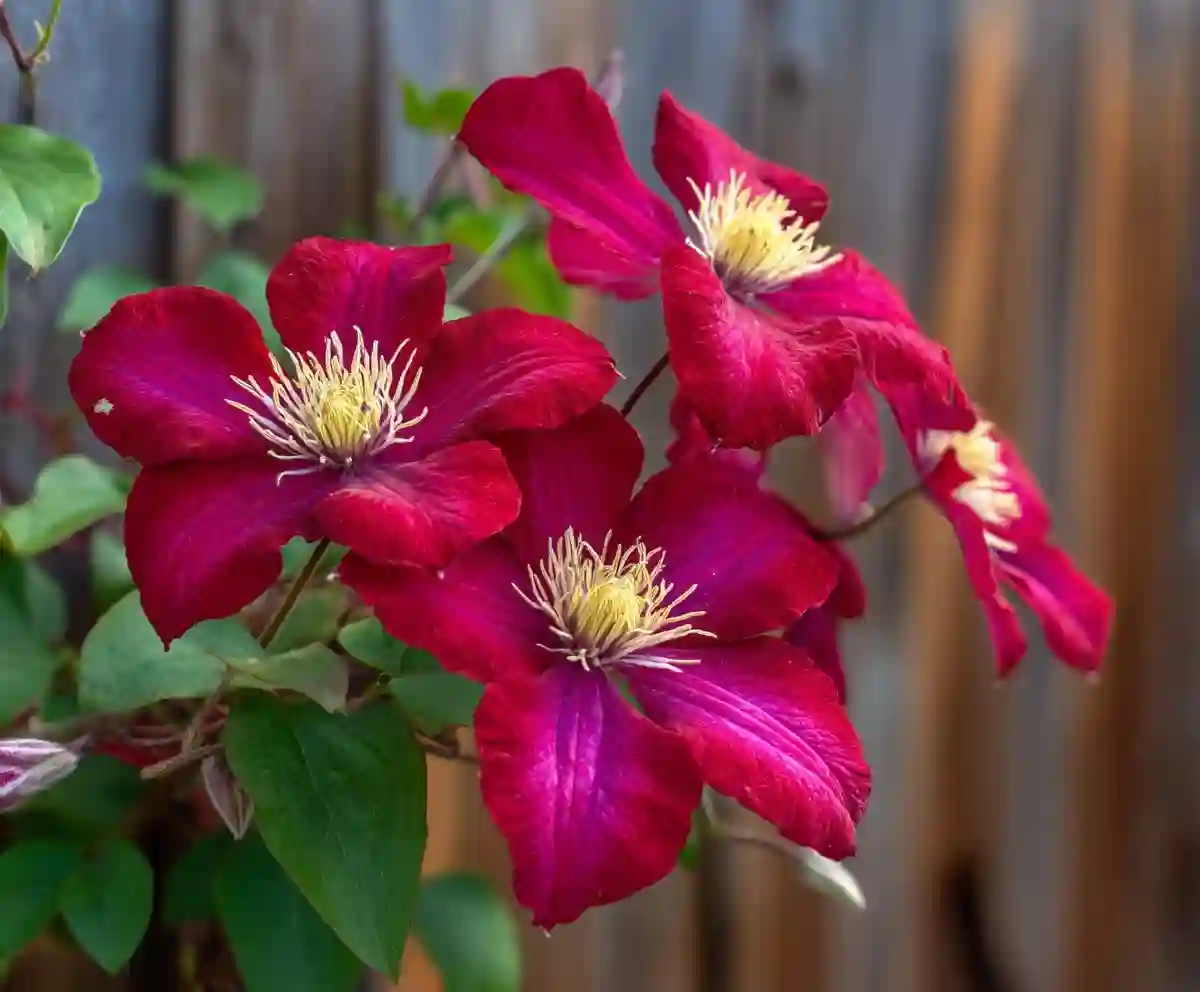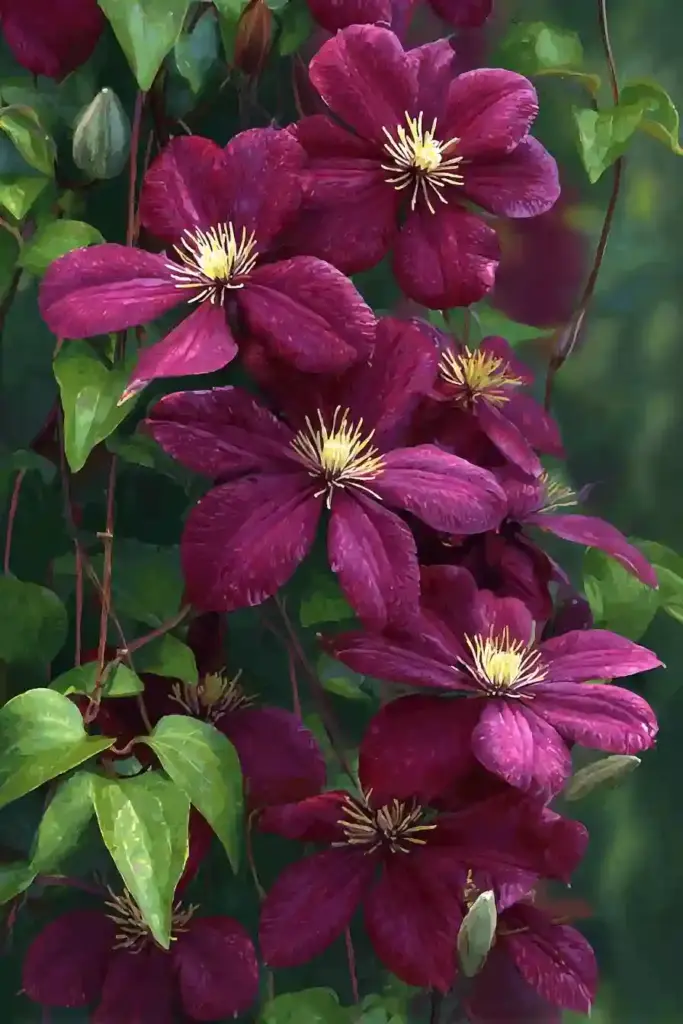Types of clematis are as varied and captivating as any flowering vine in the garden world. With hundreds of cultivars available, these climbing plants offer something for every gardener—from compact patio beauties to vigorous climbers that cover fences and pergolas with ease. Whether you’re drawn to soft pastels, vivid purples, or delicate whites, there’s a clematis variety that will complement your outdoor space perfectly. In this guide, we’ll walk you through twelve standout types of clematis that not only bring visual drama but are also easy to grow with the right care. Each one has its own personality, blooming style, and garden charm.
Table of Contents
1. Rosemoor Clematis
Rosemoor Clematis is a standout among the newer types of clematis, thanks to its remarkably long bloom time and vibrant reddish-purple petals. Bred by renowned horticulturist Raymond Evison, this variety, also known as Clematis ‘Evipo002’, produces 5–6 inch blooms from late spring through early fall—often spanning May to September.
What sets Rosemoor apart is its ability to flower on both old and new wood, giving it a continuous performance that few other vines can match. Its blossoms are accented by striking yellow stamens, making a dramatic contrast that’s impossible to miss.
This clematis prefers rich, well-draining alkaline soil and thrives when its roots are shaded and its vines reach into the sun. Consider mulching around the base or planting low-growing groundcovers to protect the root zone. Light pruning after the first bloom cycle will help maintain its vigor.
Quick Tips:
- Bloom Time: May to September
- Flower Color: Deep reddish-purple with yellow centers
- Growth Habit: Climbs fences, trellises, or large shrubs
- Ideal For: Mixed borders, cottage gardens, vertical accents
2. Rebecca Clematis
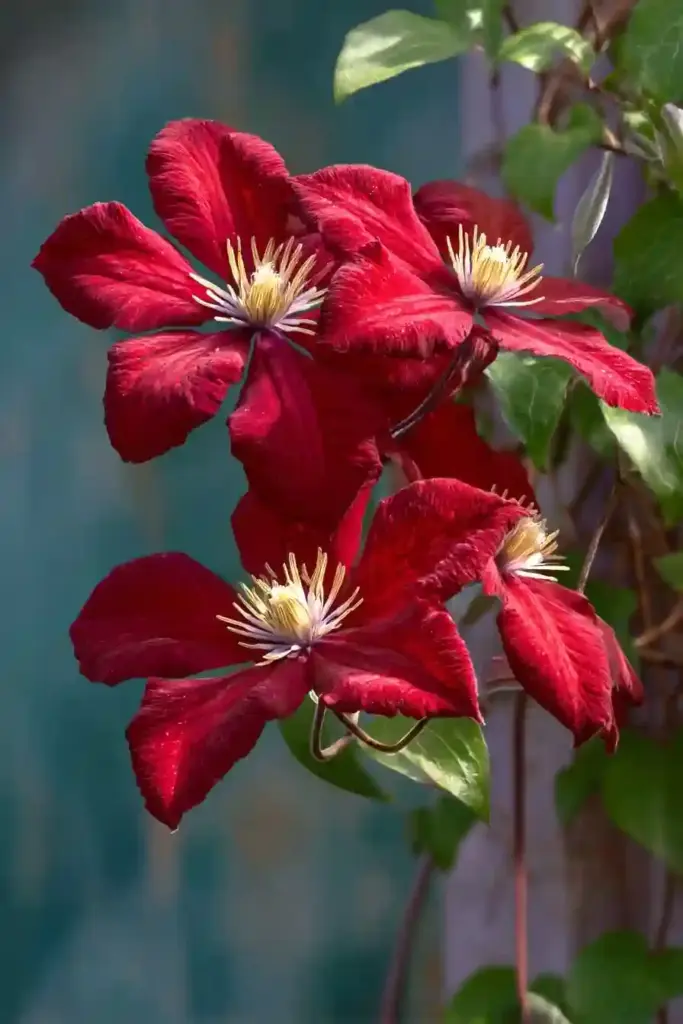
One of the most eye-catching types of clematis, Rebecca Clematis brings bold color and elegance to any garden space. Developed by Evison/Poulsen and named after breeder Raymond Evison’s daughter, this variety is known for its large, scarlet-red flowers with creamy yellow anthers.
Rebecca Clematis blooms generously in two main flushes—first from May to June, and again in late summer, often into August. Its vibrant petals hold up well in sun and provide a striking visual when trained on trellises, fences, or climbing over existing structures.
This vine benefits from a rich, porous, and slightly alkaline soil. Like most clematis, it loves having cool roots and sun-kissed blooms, so mulching or using shallow-rooted companion plants at its base is key. Provide a sturdy support for the vine, as its vigorous growth can quickly fill out a vertical space.
Quick Tips:
- Bloom Time: Late spring and late summer
- Flower Color: Scarlet red with yellow centers
- Growth Habit: Climbs easily with proper support
- Ideal For: Trellises, garden walls, or concealing unsightly areas
3. Bijou Clematis
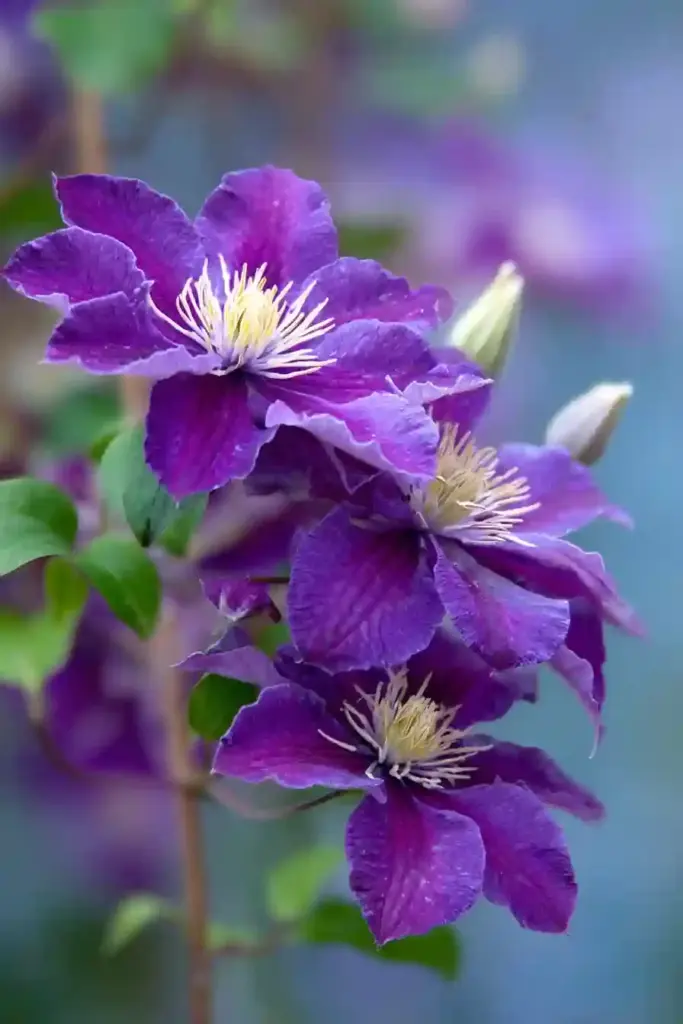
Among compact types of clematis, Bijou Clematis stands out with its petite size and surprisingly large, richly colored blooms. Also known as Clematis ‘EVIpo030’, this variety is perfect for small gardens, patios, or container displays, offering a grand floral show without taking up much space.
Bijou produces amethyst-purple flowers with ruffled edges and a silvery-white reverse—giving it a two-tone appearance that adds depth and charm. It blooms in late spring and rewards gardeners with a second flush in fall, bringing color when many other plants are fading.
This low-maintenance clematis can be used as a mounding groundcover, allowed to trail gently from pots, or supported by a small trellis for vertical interest. It thrives in full sun to partial shade and is known to attract butterflies and beneficial pollinators.
Quick Tips:
- Bloom Time: Late spring and again in fall
- Flower Color: Deep purple with silvery undersides
- Growth Habit: Compact, mounding or trailing
- Ideal For: Containers, groundcover, balconies
4. Clematis Fireworks
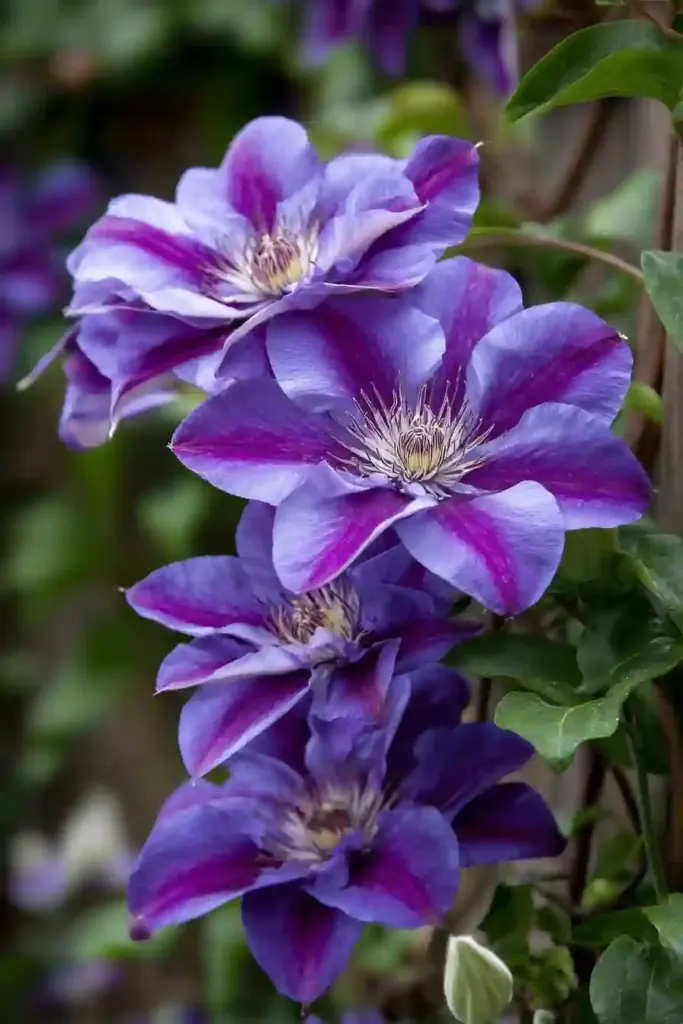
Clematis Fireworks lives up to its name with bold, 8-inch flowers that burst open in a stunning display of bluish-purple petals streaked with vibrant cerise bars. Among the showiest types of clematis, this variety is perfect for gardeners seeking dramatic, large-flowered impact.
It typically blooms in late spring to early summer, with a rebloom period in late summer, offering slightly smaller but equally vivid flowers. The petals have a slight twist and are lightly recurved at the tips, giving them a dynamic, firework-like appearance. The central tuft of white stamens adds even more flair to this standout vine.
Clematis Fireworks grows vigorously and prefers a protected location, as its large blooms can be sensitive to wind damage. Provide it with sturdy support like a trellis or arbor, and plant in rich, well-draining soil. Full sun for the top growth and shade for the roots is the golden rule.
Quick Tips:
- Bloom Time: Late spring and late summer
- Flower Color: Bluish-purple with cerise stripes
- Growth Habit: Tall climber, needs strong support
- Ideal For: Arbors, pergolas, focal points in sunny borders
5. Roguchi Clematis
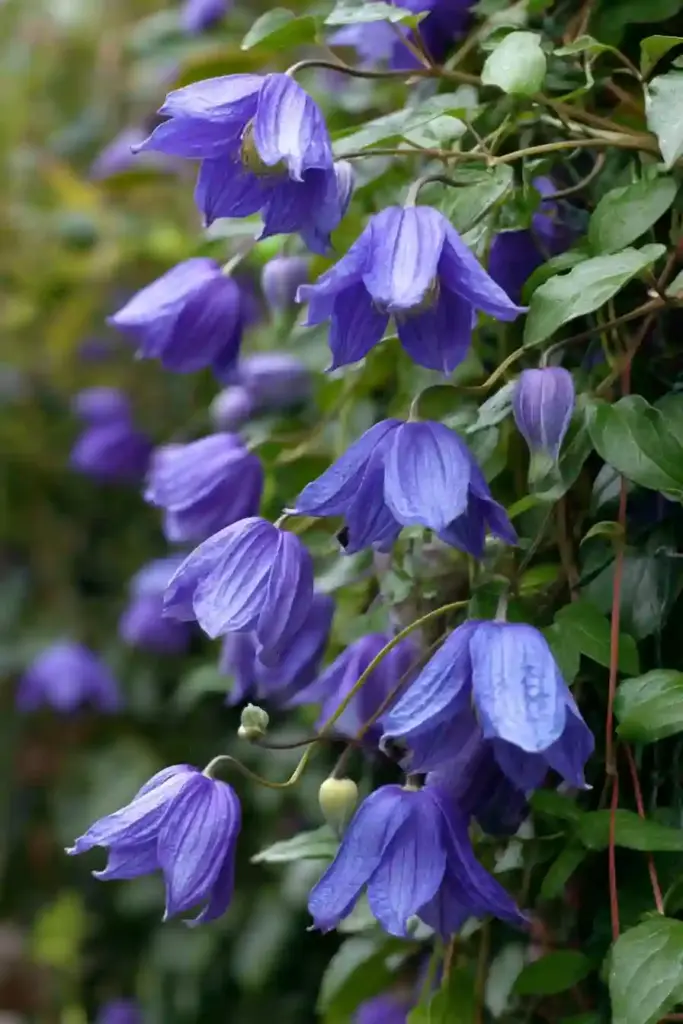
If you’re looking for something a little more unique among the types of clematis, Roguchi Clematis is a true standout. Unlike traditional flat-faced varieties, this Japanese cultivar features bell-shaped, nodding flowers in a deep violet-blue, accented with lighter recurved tips.
Roguchi is a non-clinging weaver, meaning it doesn’t twine like typical clematis vines. Instead, it gently threads its way through surrounding plants, making it ideal for naturalistic plantings or mixed borders. It’s also a favorite among gardeners who want a low-maintenance vine with a long blooming season—from June through September.
This variety is both fragrant and incredibly resilient. Once established, it’s a reliable performer. Like most clematis, it prefers rich, well-drained alkaline soil, with shaded roots and full to partial sun on top. Prune lightly in early spring to shape and remove any winter damage.
Quick Tips:
- Bloom Time: Early summer to early fall
- Flower Color: Deep violet-blue, bell-shaped
- Growth Habit: Non-clinging, ideal for weaving through other plants
- Ideal For: Cottage gardens, perennial borders, informal trellises
6. Sapphire Indigo™ Clematis
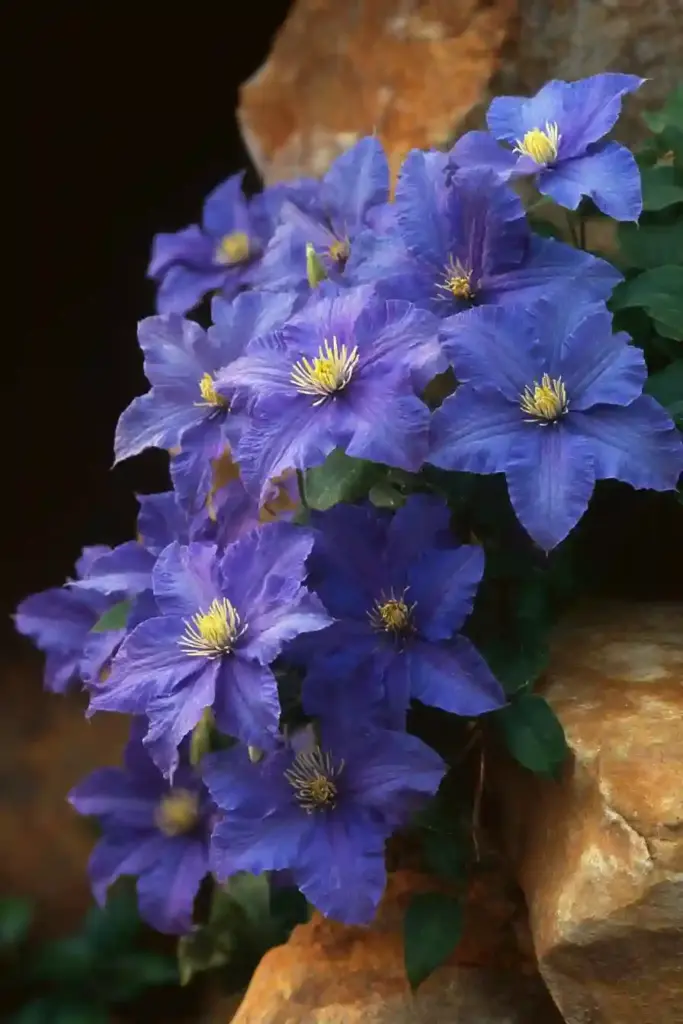
Among the more versatile types of clematis, Sapphire Indigo™ offers a compact habit with deep purple blooms that gradually fade to indigo-blue as they mature—creating a captivating two-tone effect on the same plant. What makes this cultivar especially appealing is its ability to be used as both a climber and a groundcover.
Unlike traditional vining clematis, Sapphire Indigo™ has a bushy, spreading form, which makes it perfect for containers, hanging baskets, or letting it spill over retaining walls. It starts blooming in early summer and keeps going strong through September, with very little deadheading required.
The star-shaped flowers are around 4 inches across, highlighted by prominent stamens, and are highly attractive to butterflies and pollinators. It thrives in full sun or part shade and is remarkably heat and cold tolerant, making it ideal for a wide range of growing zones.
Quick Tips:
- Bloom Time: June through September
- Flower Color: Dark purple to indigo-blue
- Growth Habit: Spreading; can climb or trail
- Ideal For: Containers, borders, small garden trellises
7. Guernsey Cream Clematis
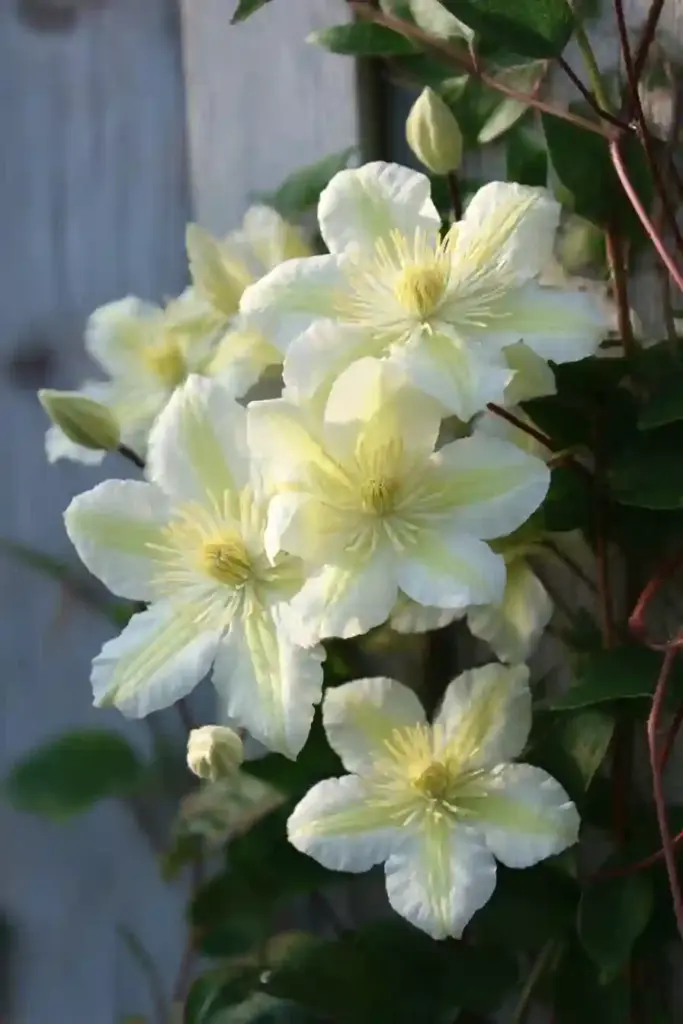
Guernsey Cream is one of the most elegant types of clematis, prized for its creamy-white flowers that open from soft yellow buds and reveal a subtle chartreuse central bar and golden stamens. Its large, rounded sepals give the plant a refined, almost luminous presence in the garden.
This variety begins blooming in late spring and often flowers again in late summer after a light trim. Guernsey Cream is ideal for gardeners who want a soft, sophisticated look that pairs beautifully with bolder plants or pastel-toned landscapes.
Though the blooms look delicate, this clematis is tough and adaptable, handling both heat and cold with ease. It stays relatively compact, making it suitable for courtyards, patio trellises, and smaller garden spaces. Provide it with partial to full sun, and be sure to mulch around the base to keep the roots cool and happy.
Quick Tips:
- Bloom Time: Late spring and late summer
- Flower Color: Creamy white with pale green bars
- Growth Habit: Compact climber
- Ideal For: Small gardens, trellises, pairing with roses
8. Pink Anemone Clematis
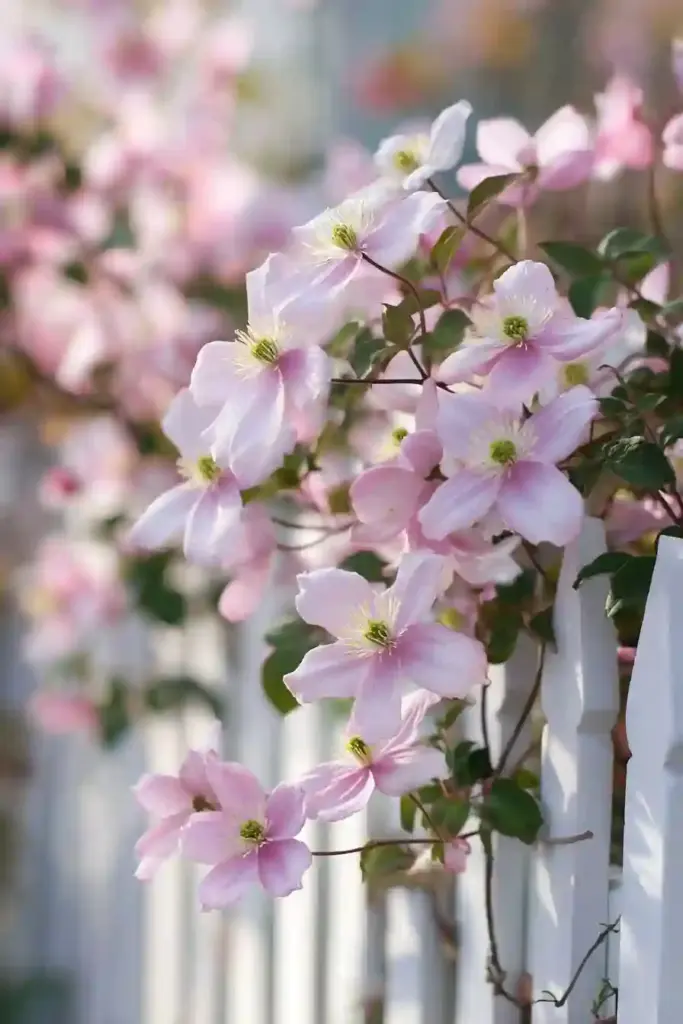
Pink Anemone Clematis (Clematis montana var. rubens) is one of the most vigorous and fragrant types of clematis, perfect for gardeners who want a fast-growing climber with masses of soft pink blooms. Each flower is a delicate shade of mauvish-pink that fades gently to pastel as the season progresses.
This variety truly shines in early summer, when its tendrils become absolutely covered in blooms, often obscuring the foliage beneath. The vine itself emerges with burgundy-tinted new growth, maturing into bronze-green leaves that add ornamental value even when it’s not in bloom.
Not just a visual stunner, Pink Anemone is also highly fragrant, filling the garden with a sweet vanilla scent that attracts butterflies, hummingbirds, and other pollinators. It thrives in full sun to part shade and works beautifully draped over fences, arbors, or old tree stumps.
Quick Tips:
- Bloom Time: Early summer
- Flower Color: Mauve-pink to pastel pink
- Growth Habit: Vigorous climber
- Ideal For: Arbors, fences, pollinator gardens
9. Warsaw Nike Clematis
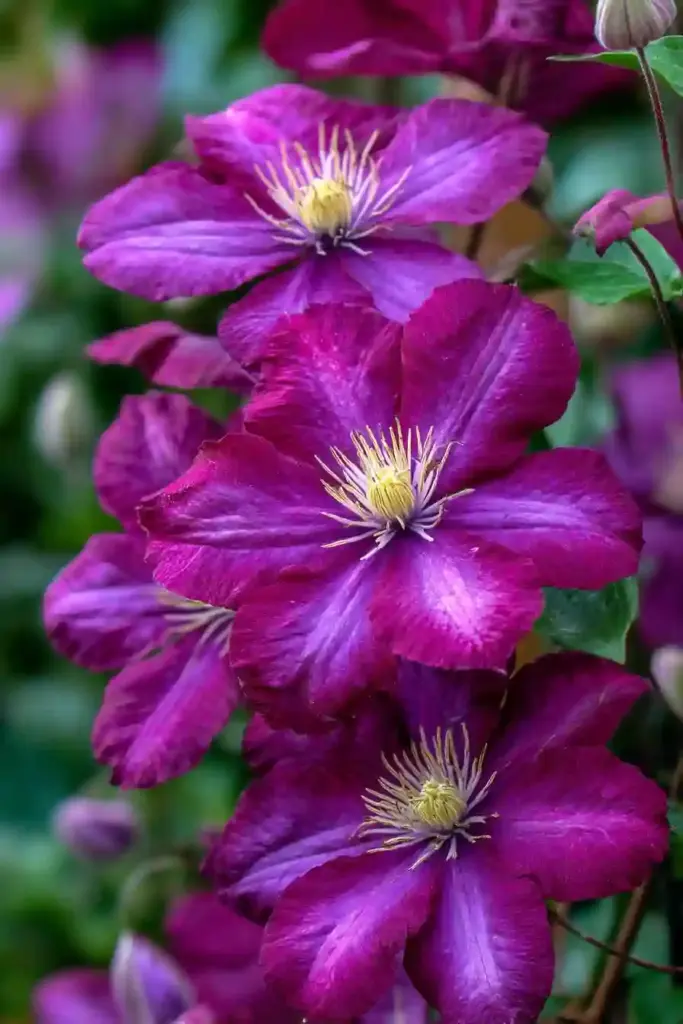
For deep, velvety color that commands attention, Warsaw Nike is one of the boldest types of clematis you can grow. Its 5-inch flowers are a rich violet-red, almost wine-colored, with a plush texture and a dramatic golden-yellow center that creates a stunning contrast.
Warsaw Nike is a reliable rebloomer, flowering first in late spring to early summer, then again later in the season with a lighter flush. What makes it especially appealing is its shade tolerance—this variety performs better than most clematis in lower-light areas or north-facing gardens.
Like others, it prefers rich, well-draining soil and benefits from mulching at the base to keep roots cool. It will need a climbing structure such as a trellis, fence, or even a large shrub to lean on.
Quick Tips:
- Bloom Time: Late spring and again in late summer
- Flower Color: Dark violet-red with golden stamens
- Growth Habit: Tall climber, shade-tolerant
- Ideal For: Part-shade gardens, north-facing walls, fences
10. Blue Angel Clematis
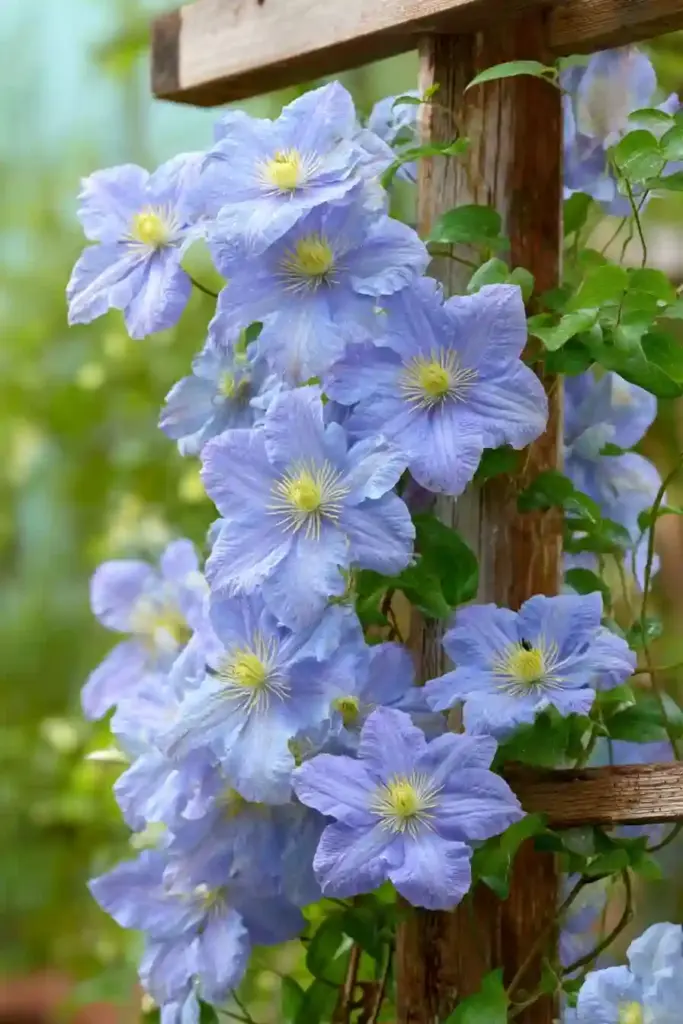
Blue Angel Clematis (Clematis ‘Blekitny Aniol’) is one of the most ethereal and delicate-looking types of clematis, with sky-blue, ruffled petals that soften toward the center and contrast beautifully with bright yellow stamens. This Polish-bred variety is celebrated for its prolific blooms and graceful, cascading form.
It flowers abundantly in late spring to early summer, with blossoms that reach up to 6 inches across. The light blue tones add a serene, cooling effect to borders and trellises, especially when paired with white or soft pink companions.
Blue Angel is known for being a vigorous climber and cold-hardy, making it ideal for temperate zones with variable weather. Like other clematis, it prefers full sun for the foliage and shaded roots, so mulch or low-growing plants near the base are recommended.
Quick Tips:
- Bloom Time: Late spring to early summer
- Flower Color: Pale sky blue with yellow centers
- Growth Habit: Tall, vigorous climber
- Ideal For: Fences, pergolas, pairing with climbing roses
11. Hyde Hall Clematis
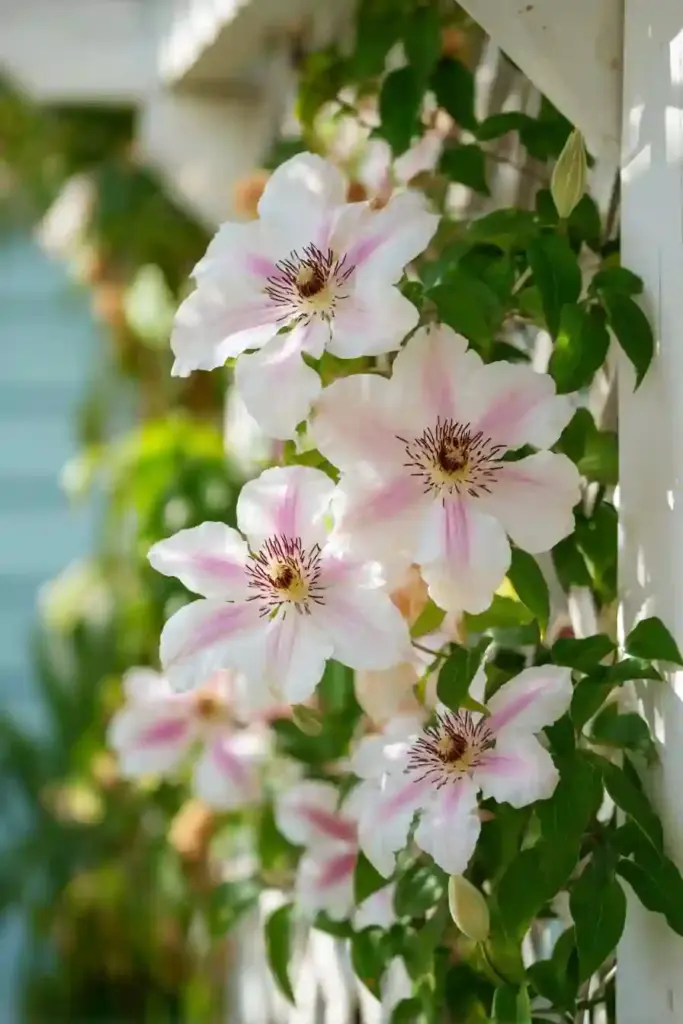
Hyde Hall Clematis is a refined, compact variety that adds a soft, romantic presence to any space. Among the lighter types of clematis, its creamy-white blooms sometimes show a subtle pink blush when young, eventually aging to a pristine alabaster hue. Each flower can span up to 7 inches, with elegantly pointed petals and a central boss of chocolate-colored stamens.
This clematis blooms on old wood in late spring to early summer, making it ideal for gardeners seeking early-season interest. It’s perfect for small gardens, patios, or balconies due to its moderate size and bushy habit.
Hyde Hall pairs beautifully with other pastel-toned flowers or can be planted solo for a clean, classic look. It thrives in partial to full sun, and its compact form makes it suitable for containers or small trellises. Be sure to prune lightly after flowering to maintain shape and promote future blooms.
Quick Tips:
- Bloom Time: Late spring to early summer
- Flower Color: Creamy white, sometimes with a pink tint
- Growth Habit: Compact, semi-double blooms possible
- Ideal For: Small spaces, containers, cottage-style borders
12. Sweet Summer Love Clematis
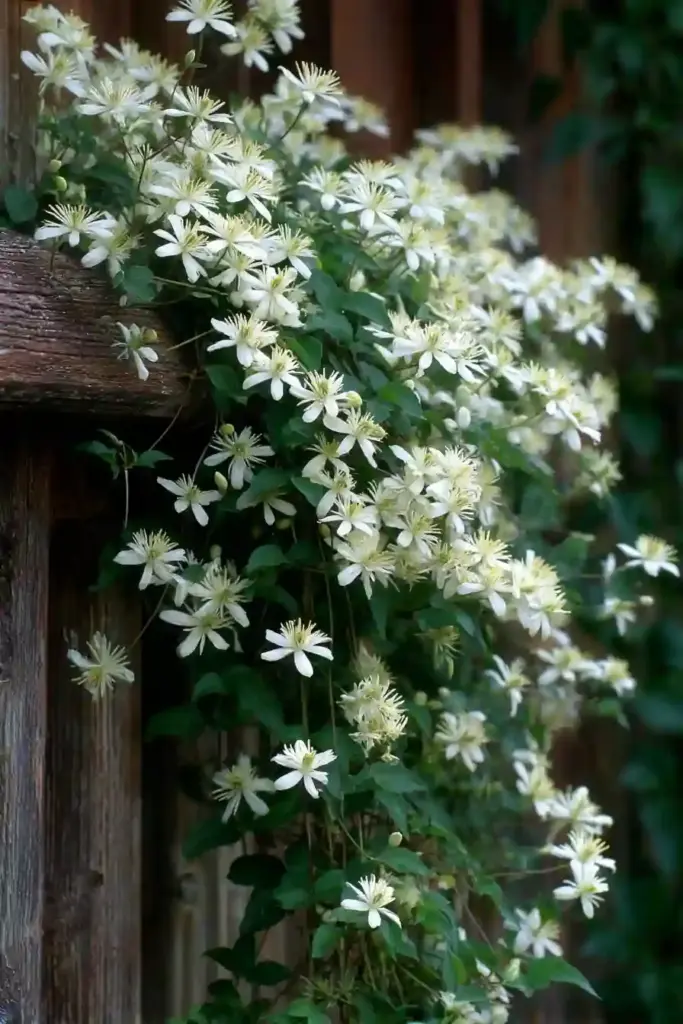
Sweet Summer Love is one of the most aromatic and vigorous types of clematis, combining intense fragrance with an explosion of star-shaped blooms. Its flowers open in deep cranberry-red and mature to reddish-purple, creating a rich, multi-toned effect across the vine.
What truly sets this variety apart is its early and extended bloom time—starting as early as mid-July and continuing into September. You’ll enjoy thousands of small but showy flowers that not only look stunning but fill the air with a sweet scent.
This deciduous vine can reach up to 12 feet tall, making it ideal for larger trellises, arbors, or fences. Despite its vigorous nature, it’s cold- and heat-tolerant, and resistant to many common diseases. Plant it in a sunny spot with its roots well-shaded, and you’ll be rewarded with a long-lasting, fragrant display year after year.
Quick Tips:
- Bloom Time: Mid-summer to early fall
- Flower Color: Deep red to reddish-purple
- Growth Habit: Vigorous, strongly scented climber
- Ideal For: Scented gardens, large arbors, privacy screens
Conclusion
With so many striking types of clematis to choose from, it’s easy to find a variety that fits your garden’s size, style, and color palette. Whether you prefer compact growers for containers or large-flowered climbers for arbors and walls, clematis vines are as rewarding as they are beautiful. Their long bloom periods, diverse colors, and pollinator-friendly traits make them a garden staple worth growing.
For the best results, remember this rule of thumb: clematis like their tops in the sun and roots in the shade. Provide support, prune according to their blooming group, and they’ll deliver spectacular displays year after year.
FAQ
When is the best time to plant clematis?
Spring or early fall is ideal. This gives the plant time to establish roots before extreme weather sets in.
How often should clematis be watered?
Water deeply once a week, more often during hot, dry weather. Keep the root zone consistently moist but not soggy.
Do clematis need fertilizer?
Yes, feed with a balanced, slow-release fertilizer in early spring and again after the first flush of blooms.
Why isn’t my clematis blooming?
Check for improper pruning, lack of sunlight, or overly dry soil. Also ensure you’re using the correct pruning group for your variety.
🌿 Love gardening inspiration? Follow me on Pinterest for bold plant ideas, tips, and seasonal color!
More Posts
